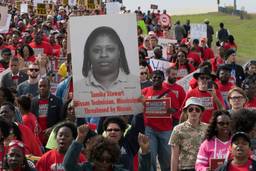
In the hours after the Democrats resoundingly won control of the House and, narrowly, the Senate, the great spin debate on the meaning of the election opened up. Did the Republicans fall because of the war in Iraq? Corruption? The economy? Bush? How about “all of the above”?
Understanding the voters’ motivations is critical for understanding how Democrats can build on this victory and what strategy they should adopt. Predictably, many conservatives are blaming the Republican Party, arguing that Americans rejected not conservatism but party politicians who acted corruptly and incompetently. And center-right Democrats are claiming the election is a mandate for center-right politics. Anti-war strategists read it as primarily a repudiation of the war. And AFL-CIO president John Sweeney opted for all of the above. “For working people, these are all different dimensions of a central reality,” he said, “a country that is being dragged hard in the wrong direction.”
Ultimately the election seems to represent a slim majority rejection of Republicans, not only for corruption and incompetence but also for their rigid ideology, a mistaken war and their neglect of – or harm to – the economic interests of most Americans. Voters may not have been clear about what the Democrats stood for, as a Democracy Corps/Campaign for America’s Future poll by Stanley Greenberg confirms, but they were nevertheless calling for Democrats to solve problems facing the majority of American working families.
In that sense, these results signal the beginning of a swing towards a pragmatic populist majority. Pragmatism does not mean thinking small or making mere symbolic political gestures. If Democrats embrace meaningful measures to solve basic problems of the majority of low and middle-income Americans, primarily related to economic security, opportunity and fairness, the pendulum can swing even further in a progressive direction.
To the consternation of Republicans, the election was largely shaped by national issues, not local ones. But there clearly were variations in the local importance of certain national issues, like corruption. And dissatisfaction with Bush among 57 percent of voters (plus disapproval of Congress by 61 percent), as well as similar sense that the country is headed in the wrong direction, framed the entire vote. It was a vote against Bush and the Republicans, more than a vote for the Democrats.
Democrats did have a minimal unified plan – including raising the minimum wage, rolling back oil company subsidies and negotiating better prices for drugs under the Medicare prescription plan – even if they did not share a clearly articulated program on many crucial issues, like Iraq. But that was enough for this election if not for future ones: Voters wanted a change, and on important broad issues, Republicans had lost their trust.
Most notably, the deterioration and prolonged duration of the war in Iraq undermined the president’s claim to be a protector of national security. Nearly three-fifths of voters in exit polls said that the war in Iraq had not improved security. They may have been divided over precisely how to proceed: Twenty-nine percent want to withdraw all troops and 26 percent want to withdraw some troops, with both groups voting heavily Democratic. But, if not the speed, the direction people want to go is clear: out.
Exit polls also showed that voters think Democrats would be only slightly less effective than Republicans in making the United States safer from terrorism, one of voters’ top issues, and the key to Bush’s victory in 2004. Yet even as discontent with the war in Iraq motivated many voters either to oppose or distrust Bush and the Republicans to provide adequate national security, it would be a mistake to see the election simply as a referendum on Iraq.
Economic issues carry the day
Both pre-election opinion polls and exit polls revealed great dissatisfaction with the economy. Adding in pocketbook issues that the exit polls did not address, such as health care and retirement security, it is clear that there is deep and pervasive anxiety among the majority of Americans about their economic security and the future of the country. Republicans had masked some of the political impact of that insecurity with the politics of the war on terrorism, but the fundamental fault lines underneath that Republican fog of fear reflect concerns about people’s livelihoods and economic stewardship of the nation.
There was a straightforward correlation between income and votes: the poorer people were, the more they voted Democratic. Likewise people with less education, who typically hold less secure or well-paid jobs, were more Democratic than any other group, with the striking exception of people with post-college education, who make up one of the strongest Democratic blocs. Indeed, one of the challenges for Democrats is figuring out how to serve the interests of its working class base as well as its more affluent (and ideologically liberal) base among professionals.
Throughout the campaign, Republicans wrung their hands about the obtuseness of American voters, who couldn’t understand what a wonderful economy they were enjoying. But for most Americans, wages have stagnated, health costs are skyrocketing, jobs in both manufacturing and high-tech sectors are moving overseas, debt is soaring, and economic insecurity is increasing. Half of voters thought the economy was either not good or poor. While the quarter of voters who saw their family financial situation getting worse voted heavily Democratic, the big group in the middle – roughly half of voters who said they had just enough to get along – also voted strongly for Democrats. A plurality of voters – 40 percent – think that life will be worse for the next generation, and two-thirds of them voted for Democrats.
Raising the minimum wage – overwhelmingly favored in polls – became a real and symbolic centerpiece of many Democratic campaigns. And in six quite varied states – Montana, Ohio, Missouri, Colorado, Arizona and Nevada – voters strongly favored higher minimum wages, in some cases with built-in cost-of-living adjustments each year. Religious leaders, including the Let Justice Roll campaign, made raising the minimum wage a moral values issue.
The working class tilt to the Democrats was reinforced by the labor movement’s most ambitious mid-term political campaign in recent history. According to a Hart Research poll for the AFL-CIO, union members voted for Democrats over Republicans 74 to 26 percent (a bit higher than the preference by union members for Democrats shown in exit polls of 68 to 30 percent). Among union members, the top issue was the war in Iraq (41 percent), but the next three issues they cited as one of their top two issues were the economy and jobs (32 percent), health care (26 percent) and retirement (26 percent) – all issues of economic security. Union voters with these top concerns voted 70 percentage points more for Democrats than Republicans.
These issues, linked to the experiences of working class voters, and labor’s mobilization efforts were decisive. Compared with all voters, union members were more Democratic by 48 percentage points, but even among groups that on average went for Republicans – such as weekly churchgoers, rural voters and married women – voters who belonged to a union voted strongly Democratic. For example, white born-again Christians voted for Republicans by a margin of 41 percentage points, but born-again union members voted Democratic by a 15- percentage point margin. AFL-CIO political director Karen Ackerman argues that Democrats beat Republicans by a cumulative total of 6.8 million votes nationwide, and union families provided 5.6 million of those votes, or 82 percent of the Democrats’ margin of victory.
Democratic candidates, even many who are conservative on some social issues, recognized the power of economic populist messages. The Campaign for America’s Future analyzed television advertising in 11 key contests and found that “the largest sums of campaign advertising were spent on economic ads that featured remarkably populist messages.” Trade agreements as such were not at the top of voters’ concerns, though they may have been part of general concerns about the economy. Global Trade Watch reports that 115 different campaigns used trade and offshoring issues and claims that in all the Democratic victories for previously Republican-held seats, fair trade advocates replaced free traders.
If the war and economic populism worked well for Democrats, two of the Republican magic bullets missed their mark. Voters ranked both terrorism and illegal immigration nearly as high as the issues that worked well for Democrats. But Republicans no longer have such a firm grip on voters’ confidence in their ability to keep America safe. And in nearly all the high-profile races, hard-line, anti-immigrant Republicans lost to Democrats who favored some comprehensive plan involving enforcement and a path to citizenship for illegal immigrants. Although 29 percent of voters said that illegal immigration was very important, 46 percent of them voted for Democrats, and only 52 percent for Republicans.
The tough line on immigration many Republicans favored seemed to have backfired for the party as a whole: While exit polls showed Bush winning 42 percent of the Latino vote two years ago, in this election Latino voters favored Democrats 73 to 26 percent. That bodes well for the Democrats’ future.
This election clearly set back the Republican dream of single party dominance of American politics. But the country is still remarkably evenly divided in political power, partly because of Republican biases built into our current electoral system due to gerrymandering. Democrats can consolidate and expand their power, but they will need to dramatically turn around the American course in Iraq – no simple task in any case, but particularly with Bush still commander-in-chief – and begin to deliver real, large-scale solutions for the economic insecurity and decline faced by the majority of Americans.

I hope you found this article important. Before you leave, I want to ask you to consider supporting our work with a donation. In These Times needs readers like you to help sustain our mission. We don’t depend on—or want—corporate advertising or deep-pocketed billionaires to fund our journalism. We’re supported by you, the reader, so we can focus on covering the issues that matter most to the progressive movement without fear or compromise.
Our work isn’t hidden behind a paywall because of people like you who support our journalism. We want to keep it that way. If you value the work we do and the movements we cover, please consider donating to In These Times.
David Moberg, a former senior editor of In These Times, was on staff with the magazine from when it began publishing in 1976 until his passing in July 2022. Before joining In These Times, he completed his work for a Ph.D. in anthropology at the University of Chicago and worked for Newsweek. He received fellowships from the John D. and Catherine T. MacArthur Foundation and the Nation Institute for research on the new global economy.







